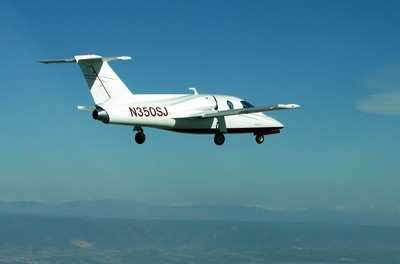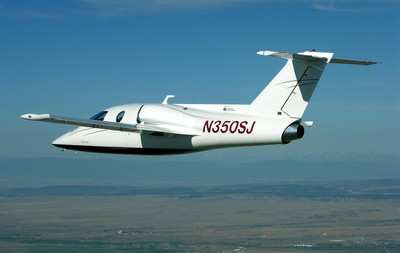Says Separation From Departing DHC-8 Wasn't Adequate; NTSB
Disagrees
 Excel-Jet, Ltd. tipped
ANN Wednesday to the planemaker's forthcoming legal action against
the FAA, regarding the June 22, 2006 crash of the company's
single-engine Sport-Jet.
Excel-Jet, Ltd. tipped
ANN Wednesday to the planemaker's forthcoming legal action against
the FAA, regarding the June 22, 2006 crash of the company's
single-engine Sport-Jet.
As ANN reported last year,
the prototype VLJ was extensively damaged during a takeoff accident
in Colorado Springs, CO. In the company's words, the aircraft
"suffered a violent un-commanded roll immediately after liftoff and
crashed." The two men onboard were taken to the hospital as a
precaution; both were released soon afterward.
"Test pilots James Stewart and Ron McElroy had accumulated 24
hours of virtually flawless flight testing," said Excel-Jet
President Bob Bornhofen. "The Sport-Jet had explored the majority
of its flight envelope without problems."
Following a 15-month investigation by the company, Excel-Jet
maintains ATC cleared the aircraft for takeoff too closely behind a
DeHavilland DHC-8 turboprop, in violation of mandatory separation
requirements -- leading to the Sport Jet's unfortunate encounter
with wake turbulence off the larger plane.
That conclusion contradicts the findings of the National
Transportation Safety Board, however. In its Probable Cause report
on the crash, the NTSB says the Sport-Jet was cleared for takeoff
approximately 90 seconds after the Dash-8... sufficient time for
any wake vortices from the larger plane to disperse, the Board
said, given weather conditions at the time.

"A wake turbulence study conducted by an NTSB aircraft
performance engineer concluded that even slight movement in the
atmosphere would have caused the circulation of the vortices near
the accident site to decay to zero within two minutes, that is,
before the time accident jet would have encountered the wake from
the DH-8," the NTSB says.
"Furthermore, easterly surface winds would have blown the wake
vortices well to the west of the runway by the time of the
accident," the Board adds. "Consequently, while in smooth air the
wake vortices from the DH-8 that preceded Sport-Jet off of the
runway may have retained enough circulation after two minutes to
produce rolling moments on Sport-Jet on the order of the rolling
moment available from the Sport-Jet's ailerons, it is most likely
that the wake vortices were neither strong enough nor close enough
to the Sport-Jet to cause the violent roll to the left reported by
the pilot and witnesses to the accident."
However, the NTSB also notes no discrepancies were found with
the Sport Jet's control systems... and investigators could not
determine why the Sport-Jet lost control.
Excel-Jet has retained the law firms of Coppola & Marlin and
Schaden Katzman Lampert & McClune -- both of which are quite
familiar with aviation litigation, the company notes. (Richard
Schaden -- an aeronautical engineer, air transport pilot, and
founder of Schaden Katzman Lampert & McClune -- was
instrumental in identifying a problem with the rudder on Boeing
737s, which led to the 1991 crash of a United Airlines 737-200 in
Colorado Springs.)

The litigation will focus on ATC procedures & operations,
and wake turbulence, according to Excel-Jet.
 ANN's Daily Aero-Linx (05.02.24)
ANN's Daily Aero-Linx (05.02.24) ANN's Daily Aero-Term (05.02.24): Touchdown Zone Lighting
ANN's Daily Aero-Term (05.02.24): Touchdown Zone Lighting Aero-News: Quote of the Day (05.02.24)
Aero-News: Quote of the Day (05.02.24) ANN FAQ: Contributing To Aero-TV
ANN FAQ: Contributing To Aero-TV NTSB Final Report: Cirrus Design Corp SR20
NTSB Final Report: Cirrus Design Corp SR20





